
Für eine deutsche Übersetzung dieser Seite einfach die Brandenburger Flagge anklicken
 |
Click the Brandenburg Flag for a German translation Für eine deutsche Übersetzung dieser Seite einfach die Brandenburger Flagge anklicken |


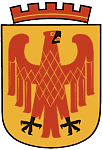 |
Home Towns - Potsdam, GermanyPotsdam's Rulers throughout the Centuries1918-2010 |
 |


 |
This site is part of our Potdam, Germany site. Click the left turn sign to get back to the Potsdam start site. |


 History is not made by individuals, but by people. However, the history made by the people is often associated with the rulers of the time. Here is a list of those who took credit and blame for Potsdam's history. We are not trying to compete with Wikipedia's comprehensive list of Rulers of Brandenburg although we have been trying to fill in some blanks here and there. Biographical references are generally limited to events affecting Potsdam and/or Brandenburg. The dates under the names don't refer to birth and death but rather to the time in office. Blue links lead to sites with more information, in most cases to a Wikipedia article. In some cases, we couldn't find an article in English language; in this case, Green links lead to articles in German language. This is Part 6 of our Potsdam's Rulers Through the Centuries site, covering the years 1918 to the present. |
 |
Click the left-turn sign to get back to the previous section. Or, if you are interested in a different time period, click the U-turn sign to get to the "Rulers" start page. |
 |


  |
Heinrich Ströbel & Paul Hirsch 1918 - 1920  To some, Prussian Republic may sound as impossible a word combination as military intelligence. But after the monarchy was toppled in the 1918 Revolution, Germany became a republic and the former kingdoms within the German Empire became "Freistaaten" - a German word for republic. First co-leaders of the Prussian revolutionary government were Independent Socialist Heinrich Ströbel, (left), and Social Democrate Paul Hirsch (right). |
 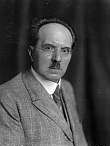 Biography at Wikipedia
Biography at Wikipedia |
 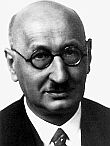 Biography at Wikipedia
Biography at Wikipedia |
 |
Ströbel and all other Independent Socialist ministers resigned in January 1919, after violent clashes between revolutionary troops and the Prussian military. Hirsch remained Prime Minister of the Prussian Republic until 1920. |

  |
Otto Braun 1920 - 1932  The first German Republic was called the "Weimar Republic" after the seat of the National Assembly that drafted its constitution. In the 14 years of its existence, the Republic had 17 different Chancellors - indicator of the political instability of the time. In this time of turmoil, the Prussian Republic was a haven of stability and democracy, governed for most of the time by the same prime minister.  Social Democrat Otto Braun became Prussian chancellor in 1920 and stayed in office until 1932, only interrupted for two short periods by Adam Stegerwald in 1921 and by Wilhelm Marx in 1925. Under his tenure, Prussia was called a "Fortress of Democracy." Amongst other reforms, Braun attempted a first agrarian reform and a democratization of the school system.  Brown was ousted by the Nazis in 1932 and spent the rest of his life in exile in Switzerland. |
 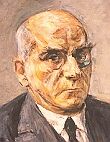 Biography at Wikipedia
Biography at Wikipedia
|


  |
Adam Stegerwald Apr. - Nov. 1921 |
 |
Wilhelm Marx Feb. - Apr. 1925 |
 |
Franz von Papen 1932 - 1933 |
 |

  |
Preussen Coup and Nazi Rule 1932 - 1945  As Ernst Thälmann, one of the Nazi's most prominent prisoners had foreseen: "Voting for Hindenburg is voting for Hitler and voting for Hitler is voting for war." Paul von Hindenburg, German President since 1925 ran for reelection in 1932. He was considered the only candidate who could defeat Hitler and won the election in a runoff. However, he played an important role in the Nazi Party's rise to power, dissolving parliament twice in 1932 and eventually appointing Hitler as Chancellor in January 1933. One of his first actions was the Preussen Coup. On July 20, 1932, Hindenburg issued an emergency decree which dismissed the cabinet of Prussia, the largest German state, thus dismissing one of the last major republican forces against the rise of the Nazis. Between the Preussen Coup and the final Nazi-takeover, Prussia was under direct control of chancellor Franz von Papen.  After the seizure of power by the Nazis, the German states lost their power and became mere administrative units. From 1933 until 1945, Prussia's official prime minister was Hermann Göring, but this title was a mere formality. |

  |
Under Nazi rule, the old Brandenburg Margraviate was reorganized as the
Brandenburg Gau.
Chief in command was
Wilhelm Kube from 1933 through 1936 and then
Emil Stürtz from 1936 until the end of the war.
Kube was killed by Belarussian resistance fighters in Minsk in 1943 and Stürtz is believed to have been captured by the Soviet armee and to
have died in captivity.
 On April 27, 1945 the Soviet Armee took Potsdam and ended Nazi rule. |
  Wilhelm Kube |
 Emil Stürtz |

  |
Soviet Military Administration 1945 - 1949  After Germany's defeat in World War II and her surrender in May 1945, Prussia was officially dissolved by the allies. The eastern parts, including Brandenburg's Neumark province were transferred to Poland. The reminder of Brandenburg became a state within the Soviet Zone of Germany.  With the arrival of the Red Army, the last Nazi-Mayor had fled the town and left it in the hands of a provisional administration under Dr. Friedrich Bestehorn. On May 1, the first Soviet Commander of Town at, Colonel Andrej S. Werin took over and appointed Mr. Bestehorn as mayor the next day. However, only twelve days later, Dr. Bestehorn was arrested by Soviet authorities and replaced by Heinz Zahn, who then in July had to give way for the town's first communist mayor, Walter Paul. |
 |
 |
In spite of their animosities, Soviet and German authorities worked relentlesly on removing the rubble, organizing food, stemming back epidemics,
rebuilding the school and health system and creating living quarters for the 40,000 people - refugees and citizens who lost their homes due to
bombing and artillery shelling.
 We couldn't find much online material about the immediate post war time which is why this part is illustrated with a picture of Soviet Marshal of the Armour Semen Bogdanov, head of the Soviet Military Administration in the State of Brandenburg from 1945 to 1947. From 1947 until 1949, this administration was led by Major General Wasilij M. Sharov, of whom we couldn't find any information.  In October 1949, the (East) German Democratic Republic was founded and formally, authority was turned over to the East German government - but the Russians kept pulling the strings for many years to come. |

  |
Karl Steinhoff & Rudolf Jahn 1945 - 1952  From 1945 until 1952, Soviet and East German authorities kept the old administrative structures, under which East Germany consisted of five states, one of which was Brandenburg. The state's prime ministers governed under Soviet and East German supervision and were members of East Germany's governing Socialist Unity Party.  First Prime Ministers from 1945 until 1949 was Karl Steinhoff (left) followed by Rudolf Jahn (right) from 1949 until 1952. |
 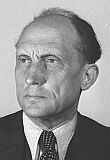 Biography at Wikipedia
Biography at Wikipedia |
 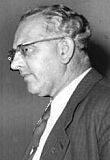 Biography at Wikipedia
Biography at Wikipedia |

  |
Potsdam District 1952 - 1990  In 1952, Soviet and East German authorities dissolved the traditional administrative structure and divided East Germany into 14 districts, one of which was the Potsdam-District. The districts were officially governed by a district council, but the real person in charge was the local First Secretary of the Socialist Unity Party. |
   Kurt Seibt |
   Günther Jahn |
  Heinz Vietze |
| First Secretaries between 1952 and 1990 were: Kurt Seibt (1952-1955), Eduard Götzl (1955–1957), Werner Wittig (1964–1976), Günther Jahn (1976–1989) and Heinz Vietze (1989–1990). Sorry, we only found pictures of three of them. |

  |
Manfred Stolpe 1990 - 2002  In East Germany, Consistorial President Manfred Stolpe was deputy chairmen of the Federation of Evangelical Churches and as such one of the very few official voices of opposition in the Communist State. After the fall of the East German regime, he became a member of Germany's Social Democratic Party and was elected to Brandenburg's State Assembly in the state's first free election since 1932. Shortly before reunification, East Germany restored the traditional administrative structure and revived the old Brandenburg Margraviate as Brandenburg State. After German reunification, when Brandenburg was one of six new states joining the German Federal Republic, he was elected Prime Minister of Brandenburg and was as such the first democratically elected head of state since Otto Braun was ousted. |
 |

  |
Matthias Platzeck 2002 -  In 1988, when Potsdam was still a town in Communist East Germany, and oposing the government still took a lot of courage, environmental activist Matthias Platzeck founded ARGUS a conservation movement that successfully prevented the demolition of large parts of Potsdam's historical architecture. In 1989, ARGUS joined East Germany's Green League, one of the oppositional groups that eventually toppled the East German regime in November 1989. In 1990, he became Secretary for Environmental Protection in Manfred Stolpe's State government. He resigned as secretary in 1998, when he was elected mayor of Potsdam. |
 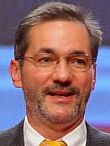 Biography at Wikipedia
Biography at Wikipedia
|
 In 2002, when Stolpe moved up to a federal office, he was elected Prime Minister. If our count is correct, he is currently the fifty third ruler of the land, ever since Albert the Bear became Margrave 850 years ago. |

 |
Thank you for traveling through 1,000 years of history with us! Pick your next destination from the links below, or click the u-turn sign to returne to the "Rulers" start site. |


 Back to Potsdam Page |
 Back to Home Towns |
 Back to Germany Page |
 Back to English Main Page |
 Back to Start Page |